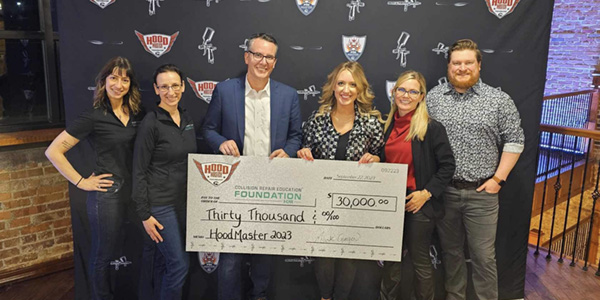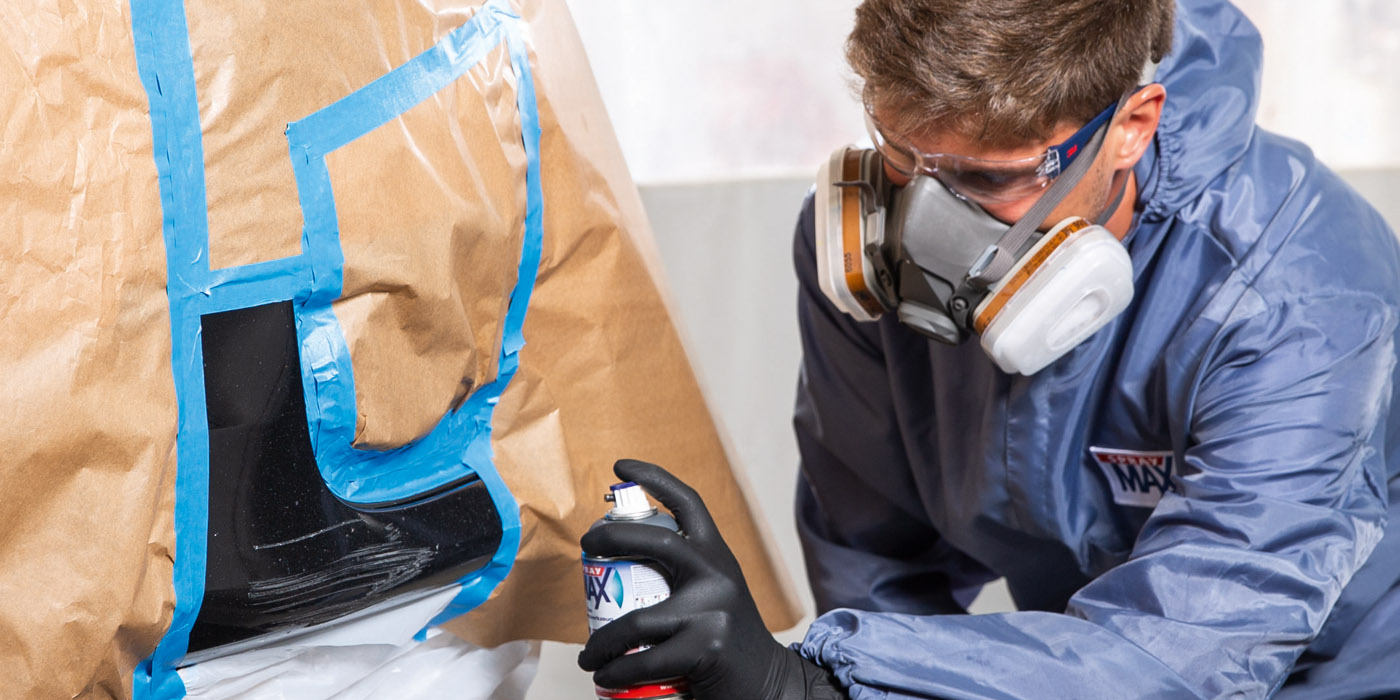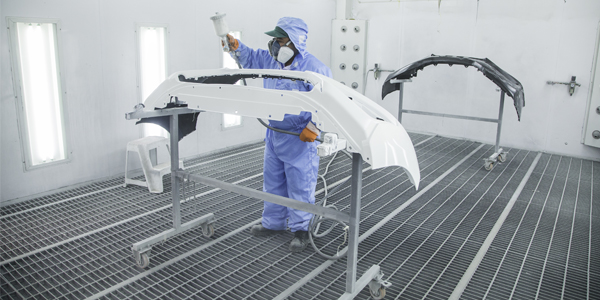Welcome to the future.
Paint company chemists have searched high and low for products that answer the call for faster production, higher gloss, better chip resistance and friendly environmental properties. And they continue to look for new combinations of ingredients to achieve paint perfection. Along the way, they decided to borrow a page from the industrial side of the coatings business and introduce ultraviolet curable coatings, which have been blended to suit the unique needs of the automotive refinishing community.
UV-cured coatings are most often a one-component package that relies on ingredients called photo initiators, which are dispersed throughout the product. When the user introduces the UV light source to the painted object, it triggers a cross-linking reaction in the coating that creates an almost-instant full cure.
It generally takes two to three minutes to reach full cure with the products currently available in the U.S. market. Full cure meaning ready to sand or buff or deliver. And that’s with no mixing, virtually no VOCs and no heat. It’s the carefully tuned UV light waves that drive the curing process.
That said, let’s take a look at some of the science behind this process, the practicality of implementing UV-cured coatings in your shop and common questions about durability, process specifics and safety.
Then Vs. Now
Hey, we’ve been painting cars, parts and pieces for a long time now. Anybody around in the ’60s would have surely sprayed a lot of acrylic lacquer. And I can’t have been the only painter who ran that fresh lacquer paint job right outside into the sun so it would dry quicker.
The key word there is DRY. Those great old lacquer products dried really well. The incredible amounts of solvent (VOC) – sometimes 200 percent – that we added to just get the paint from the gun to the vehicle would evaporate right out of that paint film. And as it left, the lacquer would shrink down to the remaining dry film, ready for me to sand and buff.
As we learned years later, the lacquer did just that: It dried. But it never cured. All we had to do was add solvent or heat, and the thermoplastic resin that was left on the vehicle would return to its liquid state. It would reverse. And that was a problem. After the vehicle left the shop, the customer would park it out in the sun, and all kinds of things could happen. Bondo Bob’s body work might surprisingly reappear.
Fortunately, due to pressures from the EPA and the need to revise paint chemistry to be safer and more productive, lacquers were essentially phased out. The first curing products we saw were the isocyanate crosslinked acrylic enamels. Once full crosslinking occurred, you could wipe these finishes down with lacquer thinner with no effect. In addition, these products went on the car looking wet – and stayed that way. A talented painter with a well-maintained spraybooth could lay out paint jobs that rivaled the OEM finish.
The introduction of acrylic urethane technology took the finish quality factor up another notch. It was about the same time as the unibody revolution. Meanwhile, the big three U.S. automakers were under the gun to clean up the pollution spewing forth from their assembly plants. Waterborne basecoats, high solids clears, high bake clears – it seemed like they were changing constantly. Many of you will remember the great orange peel contest between American vehicle manufacturers. These were the years of great challenge!
But the paint companies kept pace. As they provided new products and methods at the OEM level, they did their best to provide satisfactory products and methods to the refinish sector. The timing wasn’t always right, but a good painter, asking questions and taking his time, could produce high-quality work despite the chaos.
As the OEM processes settled in and complied with government-mandated emission requirements, the number of changes lessened and paint manufacturers were able to refine basecoat and clearcoat systems used in refinish. I’d say that by the mid-1990s, we were spraying the most amazing paint products ever offered – thin, fast basecoats with amazing hiding, wet-on-wet primer/sealers with great adhesion and flow, and clearcoats that were out-of-the-gun great. What could be better?
Profitability Suddenly Mattered
As machinery and products used to repair and refinish vehicles matured, something else was happening that would drive future changes in the collision repair marketplace: a revolution in shop management. Suddenly, seminars and speakers appeared, and so did computers – which assisted with office functions like estimating, accounting and job costing. Every step of the collision repair and refinish process was suddenly examined from every angle, and the desire to improve profitability became a driving force in what, until now, had been a fairly casually run industry.
These new business developments caused a lot of stress in the workforce. As each step of the repair came under scrutiny, a war of wills was fought by owners and workers. In the end, the boss usually got those increases in productivity that his business advisers told him he could get.
But what does this cruise through the past have to do with your possibly using UV-cured products in your shop? Everything. In the business climate of the 21st century, you can’t afford to go to market without a full toolkit.
Insurance companies – whose claim payments generate most of the revenue for collision shops – are some of the richest, most profitable business entities on our entire planet. They know how to track every single penny of every single dollar that has ever run through their accounts. And when they deal with a repair facility, they have expectations for how the relationship will work. It’s advisable for a shop owner to be ready to address these expectations.
Paint companies have been a part of the business assistance available to shop owners. All of the major paint companies have special training for shop owners and managers, as well as painters, that addresses issues like productivity and effective time management. Feedback from these meetings is routinely reviewed, and pertinent data makes its way to paint company marketing departments. And if they identify a need in the marketplace, they do their best to address it.
A lot of shop owners and painters have asked for faster ways to deal with small repairs. That tiny scratch on the fender ties up shop assets as long as a big job. Until now. By adapting an already-in-use technology – UV cure – paint companies have given your shop a chance to do small repairs faster than ever thought possible. And whether this small repair is the original claim on the vehicle or a well-presented upsell to a customer already in your shop, this means additional revenue for you – and more satisfied customers.
Enter UV-Cured Coatings
The actual chemistry of the coatings is quite intense: “Recently, chemists from … company evaluated several amine synergists in a basic UV-curable formulation. They compared MDEA (methyldiethanol amine) with acrylated amine (AA) … A formulation containing the workhouse epoxy acrylate oligomer and monomers commonly used in the UV-cure coatings industry was tested with a hydrogen-abstracting photoinitiator and varying amine synergists.” – pcimag.com (the paint and coatings industry magazine’s Web site).
Wow! I’m glad that’s over. Try to say that three times fast!
The fact is, the product you spray is paint. And it’s got resins and fillers and additives to give it properties that are desirable for our business – holdout, UV resistance, gloss retention (in the case of clears) and chip resistance.
The products you’ll see being offered are generally clear in nature; that’s to facilitate the UV cure and allow the light rays to penetrate all through the film. The primers have the capability of very high build in one application. But the super speedy cure is dependent on an even application of UV light rays to the entire repaired area.
Additional labor-saving factors are unlimited pot life – meaning no gun cleaning between each repair, meaning savings in solvent and labor times – and the cure is achieved with light rays, not heat – energy savings for sure!
UV 101
The visible light spectrum is the key behind UV-cured coatings, and it’s only a small part of the entire electromagnetic wave spectrum. Radio waves are at one end, and x-rays at the other. Somewhere in the middle are the light waves we normally see with our eyes. These are tucked between infrared and ultraviolet. The sun emits UV radiation in essentially three bands: UVA, UVB and UVC. The much-talked-about ozone layer filters out almost all of the UVB and UVC, leaving about 99 percent of what reaches us UVA. UVA is generally considered the least harmful. Still, it does contribute to skin aging, DNA damage and possibly skin cancer.
UVB and UVC have some industrial uses but are NOT a part of the equipment used to cure automotive UV products. The filter glasses that are part of curing equipment available to shops filter out any and all of the UVB that might be present. And with the curing equipment currently being marketed to shops today, if you’re not directly in front of the lamp, there’s virtually no exposure to the UVA light.
For personal safety, you still should wear eye protection that’s rated for UV protection. You should also use common sense and treat the UV light source as a power tool. All lamps should be UL approved; UL has issued a spec #2422 that’s directly applicable to UVA producing lamps used in automotive refinishing.
Basic paint shop safety rules apply like with any other sprayed paint product. Wear a respirator, wear safety glasses and wear gloves when handling wet paint products. And read technical data sheets and MSDS sheets to acquaint yourself with any qualities of the products you use that you might not be familiar with.
Using the Products
Clean and prepare your panel as you normally would before priming, and apply the primer-surfacer according to directions. Wheel up the old light source, turn it on and wait two to three minutes. At that point, the repair is 100 percent fully cured and ready for sanding and topcoat application. Not bad!
Some of the products being marketed can even be cured in regular sunlight. Just remember that the repaired area must receive an even exposure to UV to cure completely. I know that Northeastern Ohio wasn’t part of the test market for sunlight curing. But some of you lucky folks could take advantage of this particular quality. Keep in mind that regular sunlight contains only about 5 percent UVA, so dry times may differ from a powered light source.
Will UV Work for Me?
What percentage of your repairs involve only one or two panels? How often do folks in your market area come in for tiny dings and scratches? Do local insurers express the wish for faster turnaround on small jobs?
Maybe you want to aggressively go out in your market and tout a one-day repair policy to generate customer interest and new business. Using an index card as a qualifier, you might say that if the damage is smaller than this, we can have your car done in one day.
Perhaps your estimators want to look for opportunities on every vehicle that comes in for service – for the chance to get additional revenues into your shop.
What do nearby mechanical repair shops do when one of their employees scratches or dings a car?
Although this technology has been modified for auto refinishing – and seems new to us – it’s been in place for years. But only you can decide if this new technology has a place in your shop. Your paint distributor and paint company salesman can assist you in reaching a decision.
After researching and speaking with manufacturers of UV coatings and equipment, I know I was impressed. Back when I was a painter, there was often a car in the shop with only a small damaged area – and it burned me up to use one of my stalls on a job like this. There’s also the ability to keep a gun full of UV primer always ready and the incredible speed available for priming and now even clearcoat repairs.
If you haven’t yet at least investigated UV curing, what are you waiting for?
Writer Michael Regan worked on the paint side of the collision repair industry for 36 years and lives in Northeast Ohio. These days, he can be found teaching cooking classes, playing guitar and piano and baking some of the best cakes that money can buy. You can contact him at [email protected].













